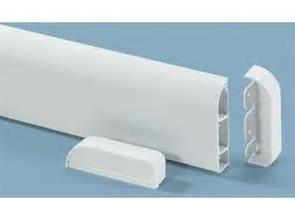Installation of the skirting board is the final stage of any repair in the room. After the installation of parquet, laminate or linoleum is completed, the question arises as to which skirting board to choose from among the whole variety of its shapes and colors.
The most common skirting boards made of wood and plastic (PVC). This finishing element should be matched to the tone of the floor or one tone darker or lighter.
Plastic skirting board is suitable for those rooms in which the floor is covered with tiles, linoleum or carpet.
The use of plastic in the manufacture of skirting boards allowed manufacturers to obtain complex and elegant forms, implemented in a rich color scheme. The most convenient is a skirting board equipped with a cable channel. Compared to wood, it is flexible and helps hide small flaws in walls and flooring. In addition, thanks to the rubberized inner surface of such a baseboard, the possibility of gaps between it, the wall and the floor is excluded.

Due to its simple design (main and decorative strips), the installation of a skirting board with a cable channel is quite simple to carry out independently without the help of specialists. To do this, the main strip is neatly fastened with screws to the wall. Next, cables are placed in it and then closed with a decorative strip fixed to the latches. If it becomes necessary to add or remove one of the cables, this strip can be easily removed and provides access to wiring. Due to the limited space of the cable channel, experts recommend installing the baseboard simultaneously with the main cables, placing them inside the main strip.
To cover the joints of adjacent stripes of the baseboard, as well as to trim the corners, special fittings are offered, which are represented by a connecting element, an inner and outer corner, and end caps.
Wooden skirting boards go well with laminate, cork and parquet. Before mounting the baseboard, it must first be prepared. To do this, the wooden product is treated with some abrasive material, then primed and painted. In addition, if the baseboard is new, it is advisable to keep it in the room for a day, so that the tree gets used to humidity and temperature and does not deform in the future.
Installation of a wooden baseboard, as a rule, should start from the inside corner. Two strips with the help of a miter box or a
circular saw are sawn at an angle of 45 degrees (this docking looks more neat) and are attached to the corner. Next, the rest of the baseboards are prepared. To fix them, nails are used (for these purposes it is better to choose corrugated or without hats), which drive in about every meter. Previously, in a tree at the intended place of attachment, it is necessary to make a small recess for the heads of the nails (then it must be covered with putty of a suitable color). When installing the baseboard, do not forget that it may be mechanically damaged, so this work must be done carefully, without rushing.
Alternatively, glue or liquid nails can be used for fastening . In this case, the adhesive mixture is applied along the entire length of the wooden strip or in dots every 20 cm. Then the skirtings must be pressed firmly against the wall and fixed for a day, supporting with heavy objects.
A correctly selected baseboard will bring completeness to your interior, and competent installation and operation will extend the life of this element of decor.